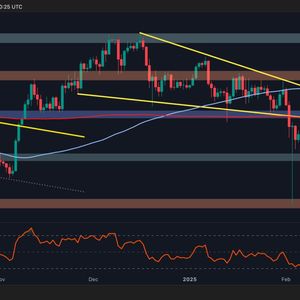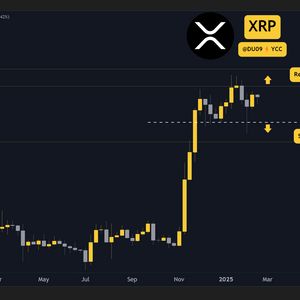Cryptocurrency investors are keenly watching traditional financial markets for signals that could ripple into the digital asset space. The AUD/USD pair is currently under a microscope as traders brace for a pivotal event: the Reserve Bank of Australia’s (RBA) upcoming rate decision . Will this decision trigger a significant move in the Aussie Dollar and potentially impact broader market sentiment? Let’s dive into the factors influencing this crucial forex pair. Why is the Market Focused on the RBA Rate Decision? The Australian Dollar (AUD) is currently navigating choppy waters, hovering around 0.6345 against the US Dollar (USD) in early Asian trading sessions. The primary driver of this market tension is the widespread anticipation of a potential interest rate cut by the Reserve Bank of Australia (RBA) on Tuesday. If the RBA proceeds with this cut, it would be the first in four years, marking a significant shift in monetary policy. Market analysts widely expect the RBA to trim its Official Cash Rate (OCR) by 25 basis points (bps), bringing it down to 4.10%. This dovish expectation is weighing heavily on the Australian Dollar as traders anticipate reduced returns on AUD-denominated assets. Craig Vardy, head of fixed income at BlackRock Australasia, aptly summarizes the RBA’s dilemma: “The prudent action for the RBA now would be to cut, but cut slowly and just see how data evolves through time. The worst thing they could possibly do is cut hard and then have to reverse.” What Factors are Influencing the AUD/USD Exchange Rate? Several key factors are currently in play, shaping the trajectory of the AUD/USD pair: RBA Rate Cut Speculation: As discussed, the looming RBA decision and the strong probability of an interest rate cut are the dominant forces pushing the AUD lower. US Tariff Uncertainty: Counterbalancing the RBA pressure is the potential delay in implementing former US President Donald Trump’s proposed tariffs. The slower-than-expected progress on these tariffs is easing concerns about immediate global trade disruptions, offering some support to risk-sensitive currencies like the AUD. Weak US Economic Data: Recent disappointing US Retail Sales data, showing a 0.9% decline in January, has exerted selling pressure on the Greenback. This weakness in the USD provides a degree of respite for the Australian Dollar . Understanding the Fundamentals: What Drives the Australian Dollar? To truly grasp the movements of the Australian Dollar , it’s crucial to understand its fundamental drivers. Here’s a breakdown of key factors: Factor Impact on AUD RBA Interest Rate Decisions Higher rates generally support AUD; lower rates weaken AUD. Iron Ore Prices As Australia’s largest export, rising iron ore prices typically boost AUD. Chinese Economic Health Strong Chinese economy (Australia’s largest trading partner) strengthens AUD. Trade Balance Positive trade balance (more exports than imports) is AUD-positive. Market Sentiment (Risk-On/Risk-Off) Risk-on sentiment generally favors AUD; risk-off sentiment weakens AUD. Australian Dollar FAQs: Key Questions Answered Let’s address some frequently asked questions to deepen your understanding of the Australian Dollar : What key factors drive the Australian Dollar? Several factors influence the Australian Dollar (AUD). Primarily, the Reserve Bank of Australia’s (RBA) interest rate policy is paramount. Being a resource-rich nation, iron ore prices, Australia’s top export, are also crucial. The health of the Chinese economy, Australia’s largest trading partner, plays a significant role, alongside domestic factors like inflation, economic growth, and the trade balance. Furthermore, global market sentiment – whether investors are embracing risk or seeking safety – impacts the AUD, with risk-on periods generally benefiting the currency. How do the decisions of the Reserve Bank of Australia impact the Australian Dollar? The Reserve Bank of Australia (RBA) exerts considerable influence over the Australian Dollar (AUD) through its control of interest rates . By setting the rate at which Australian banks lend to each other, the RBA shapes the broader interest rate landscape of the economy. The RBA’s primary objective is to maintain inflation within a 2-3% target range, adjusting interest rates accordingly. Higher interest rates relative to other major economies typically bolster the AUD, while lower rates tend to weaken it. The RBA also employs quantitative easing and tightening measures to manage credit conditions, with easing being AUD-negative and tightening AUD-positive. How does the health of the Chinese Economy impact the Australian Dollar? China’s economic performance is a major determinant of the Australian Dollar’s (AUD) value, given that China is Australia’s largest trading partner. A robust Chinese economy translates to increased demand for Australian raw materials, goods, and services, thereby boosting demand for the AUD and driving its value upward. Conversely, a slowing Chinese economy reduces this demand, putting downward pressure on the AUD. Consequently, positive or negative surprises in Chinese economic data often trigger direct reactions in the Australian Dollar exchange rates. How does the price of Iron Ore impact the Australian Dollar? Iron ore, Australia’s leading export, significantly impacts the Australian Dollar (AUD). With China as the primary destination for Australian iron ore, fluctuations in iron ore prices directly influence the AUD. Generally, rising iron ore prices lead to an appreciation of the AUD due to increased demand for the currency. Conversely, falling iron ore prices tend to weaken the AUD. Higher iron ore prices also contribute to a more favorable trade balance for Australia, further supporting the AUD. How does the Trade Balance impact the Australian Dollar? The trade balance, representing the difference between a nation’s exports and imports, is another crucial factor influencing the Australian Dollar’s value. Strong demand for Australian exports generates surplus demand for the AUD from international buyers seeking to purchase these exports. A positive trade balance, where exports exceed imports, strengthens the AUD, while a negative trade balance has the opposite effect, weakening the currency. Navigating the AUD/USD Landscape: Key Takeaways The AUD/USD pair is currently in a state of flux, heavily influenced by the anticipated RBA rate decision . While the expectation of an interest rate cut is exerting downward pressure on the Australian Dollar , factors like potential delays in US tariffs and recent US economic data are providing some counterweight. For traders and investors, closely monitoring the RBA’s announcement and subsequent market reactions will be crucial in the coming days. Understanding the fundamental drivers of the AUD, including interest rates , commodity prices, and global economic conditions, remains essential for informed decision-making in the forex market. Share: Feed news Disclaimer: This analysis is for informational purposes only and does not constitute financial advice. Trading forex and cryptocurrencies involves significant risk. Conduct thorough research and consult with a financial advisor before making any investment decisions. To learn more about the latest Forex market trends, explore our article on key developments shaping currency valuations and trading strategies.




















